- Home
- Haruki Murakami
Absolutely on Music: Conversations With Seiji Ozawa Page 14
Absolutely on Music: Conversations With Seiji Ozawa Read online
Page 14
OZAWA: I see what you mean.
MURAKAMI: And on top of that, he was a Jew. But come to think of it, the city of Vienna gained a lot of its vitality by taking in culture from its surroundings. You can see this in the biographies of Rubinstein and Rudolf Serkin. Viewing it this way, it’s easy to see why popular songs and Jewish klezmer melodies pop up in Mahler’s music all of a sudden, mixing into his serious musicality and aesthetic melodies like intruders. This diverse quality is one of the real attractions of Mahler’s music. If he had been born and raised in Vienna, I doubt that his music would have turned out that way.
OZAWA: True.
MURAKAMI: All the great creators of that period—Kafka, Mahler, Proust—were Jews. They were shaking up the established cultural structure from the periphery. In that sense, it was important that Mahler was a Jew from the countryside. I felt that strongly when I was traveling around Bohemia.
There’s Something Funny About the Third and the Seventh
MURAKAMI: Now, regarding Bernstein’s performances of Mahler in the sixties, the emotional input seems to be a major element in his case. He seems to be projecting himself onto Mahler with enormous passion.
OZAWA: Yes, the passion is there, no question.
MURAKAMI: He seems to have had tremendous empathy for Mahler’s music, a deep personal involvement. I’m sure it was important to him that Mahler was a Jew.
OZAWA: Yes, very important, I think. Lenny felt that element very deeply and was very conscious of it.
MURAKAMI: I get the feeling, though, that—for lack of a better way of putting it—there’s a kind of ethnic quality that has tended to diminish in recent Mahler performances. In yours, for example, or Claudio Abbado’s, such coloration is relatively pale.
OZAWA: It’s not an area of special concern to me, but Lenny felt that element very deeply and was very conscious of it.
MURAKAMI: And not just because Mahler’s music contains what might be called Jewish elements, I suppose?
OZAWA: No, I don’t think it was just because of that. In Lenny’s case, that kind of connection was probably very strong. It was the same for the violinist Isaac Stern. And Itzhak Perlman, of course, though more so when he was young. It’s the same with Daniel Barenboim, too. I’m close with all of these musicians, but there are areas deep down where I can’t fully grasp what they’re feeling or thinking. And I’m sure it’s the same for them where I’m concerned—a guy like me with a Buddhist father and a Christian mother and practically no religious feeling of my own: I suspect they think they can’t fully understand me!
MURAKAMI: But is there actually friction there, because of being just “Christians” and “Jews”?
OZAWA: No, none at all.
MURAKAMI: So you’re just saying that Bernstein felt a strong Jewish tie to Mahler and his music, right? And of course, in Bernstein’s case, there must have been a strong sense of commonality with Mahler in being both a conductor and a composer.
OZAWA: Looking back on it now, though, I feel I was in New York during the orchestra’s most interesting period. I was able to be right there, by Bernstein’s side as his assistant, when he was most feverishly grappling with Mahler. It was almost uncanny to see how he threw himself into the music—the total absorption. As I keep saying, I only wish I had had better command of English back then. He had so much to say during rehearsals, but I could only understand a fraction of it!
MURAKAMI: But you could tell how the sound of the orchestra would change when he gave them instructions, I’m sure.
OZAWA: Of course I could tell as I watched the rehearsal unfold, but in Lenny’s case, he would often interrupt the rehearsal itself and talk to the musicians. Then I couldn’t tell what he was saying. But you know, these talks of his were very unpopular with the orchestra members. There was only a certain amount of time for rehearsals, and the longer he talked, the less time there was to rehearse. So then you had a lot of irritated musicians who became even more annoyed if the rehearsal ran over.
MURAKAMI: What would he talk about? His opinions on the meaning of the music?
OZAWA: For the most part, he would talk about the meaning of the music, but then he would go off on tangents, like, “Oh, that reminds me, when I went to so-and-so’s place last time…” and go on forever about stuff like that until people got fed up.
MURAKAMI: I guess he liked to talk.
OZAWA: He liked it and he was good at it, and he could be very convincing, which is why I still regret the fact that I couldn’t really understand what he was saying.
MURAKAMI: I suppose you were right there with him, observing his rehearsals and taking notes.
OZAWA: That’s right, but I’d get totally lost whenever he launched into his long monologues.
MURAKAMI: Did you ever find yourself in a situation where you had read the score and heard the music in your head, but then when you heard the actual music that Bernstein was making with the orchestra, it sounded totally different to you?
OZAWA: Oh, sure, that happened all the time. That’s because I was still reading Mahler scores with the same mind-set as when I read Brahms. It could be a total shock to hear the orchestra playing what I’d read that way.
MURAKAMI: Whenever I listen to one of those long Mahler symphonies, I find myself thinking that if it were a Beethoven or a Brahms, I’d know pretty much how it was structured and it might not be that hard to learn the movements in order. But is it possible for a conductor to fit the entire complex construction of a Mahler piece inside his head?
OZAWA: In the case of Mahler, the important thing is not so much to learn it, as to immerse yourself in it. If you can’t do that, you can’t do Mahler. The works are not that hard to learn. The challenging thing is whether or not you can get inside a work once you’ve learned it.
MURAKAMI: I often find myself incapable of grasping the order in which the music unfolds. Take the fifth movement of the Second Symphony, for example. It goes this way and that way and I start wondering why it does what it does at any one point…and before I know it my brain has turned to mush.
OZAWA: Yeah, there’s no logic to it at all.
MURAKAMI: No, none at all. That never happens with Mozart or Beethoven.
OZAWA: Because their works adhere to certain forms. The point with Mahler was to destroy those forms, deliberately. So in a sonata form, where the piece is telling you, “Here, I want you to go back to this melody,” he’ll bring in a whole new melody. In that sense, of course, his works can be hard to learn—but if you study them properly and if you immerse yourself in the flow, his pieces are not that difficult. You do have to spend time on them, though, to get to that point—a lot more time than with a Beethoven or a Bruckner.
MURAKAMI: When I first started listening to Mahler, I used to wonder if he wasn’t just fundamentally mistaken about how to go about creating music. I sometimes feel that way even now. Why is he doing this in this part of the composition? But over the years, those very passages have gradually become a source of pleasure for me. There will always be a kind of catharsis at the end of the process, but in the meantime, I’m often at a total loss.
OZAWA: That’s especially true of the Seventh and the Third, even for those of us who are playing the music. If you don’t concentrate hard and do things exactly right, you end up drowning along the way. The First is fine, the Second is fine, and so are the Fourth and Fifth. There’s something a little strange about the Sixth, but ultimately, it’s okay, too. But the Seventh, wow, that’s a real problem. And the Third is another weird one. Once you get to the Eighth, you’re already into the huge ones, and you can make it work one way or another.
MURAKAMI: There are still some inscrutable parts in the Ninth, of course, but, I don’t know, with that one you’re in a whole different category.
OZAWA: You know, I once traveled all over Europe conducting the Third and the Sixth. With the Boston Symphony.
MURAKAMI: Talk about an austere pair of symphonies!
OZAWA: The Boston Symph
ony was famous for its Mahler renditions at the time, and we got lots of invitations from Europe specifically to play Mahler. That was a good twenty years ago, though.
MURAKAMI: That was the time when Bernstein and Solti and Kubelik were the big names in Mahler performance. With you as conductor, the Boston became famous for having a somewhat different feel.
OZAWA: We were among the earliest orchestras to gain a reputation for performing Mahler. [He eats a piece of fruit.] Mmm, this is good. Mango?
MURAKAMI: No, it’s a papaya.
Seiji Ozawa and the Saito Kinen Perform the Titan
MURAKAMI: At this point, I’d like to listen to the Saito Kinen Orchestra performing the third movement of Mahler’s First Symphony, conducted by you. It’s from a DVD performance taken at the Matsumoto music festival.
When the solemn (but in no way severe) funeral march, with its air of mystery, comes to an end, a traditional Jewish folk melody suddenly begins (2:29).
MURAKAMI: I always find this part—what?—extraordinary? It’s certainly in no way ordinary.
OZAWA: You’re right about that. The way this Jewish melody pops out after the funeral music: it’s a crazy combination.
MURAKAMI: But think of what a shock it must have been to the Viennese of the day to have music like this played for them all of a sudden.
OZAWA: A huge shock, I’m sure! And in terms of technique, in something like this traditional Jewish musical passage, the violins play what they call col legno—striking the strings with the wooden part of the bow instead of the horsehair part—which produces a very crude sound.
MURAKAMI: Did other composers use the technique before Mahler?
OZAWA: Hmm, I wonder—certainly none of the symphonies of people like Beethoven, Brahms, or Bruckner used it. It may be there in Bartók, say, or Shostakovich.
MURAKAMI: Definitely, when you’re listening to Mahler, you come across these passages where you have to wonder, “How are they making that sound?” If you listen closely to contemporary music, though, especially in movies, they use sounds like that every now and then—in John Williams’s Star Wars music, for example.
OZAWA: That’s the Mahler influence, I’m sure. But anyhow, just looking at this movement, it’s packed full of all sorts of those elements. It’s amazing that he was able to do that. Back then, his audiences must have been astounded.
The funeral march returns (4:30), and then (5:20) a beautifully lyrical melody makes its appearance, the same melody that concluded Mahler’s Lieder eines fahrenden Gesellen.
MURAKAMI: Here again, the mood of the music undergoes a dramatic change.
OZAWA: Yes, this is a pastoral, finally, a song of paradise.
MURAKAMI: Yes, but it comes out of nowhere, without any logical connection to anything that came before. There’s no sense of inevitability to it.
OZAWA: No, none at all. Listen to that harp: it’s supposed to be reminiscent of a guitar.
MURAKAMI: Oh, really?
OZAWA: The performers have to forget what they were just playing, adjust to a new mood, and completely immerse themselves in this new melody.
MURAKAMI: You mean to say that the people who are making the music aren’t supposed to think about meaning or inevitability? They’re just supposed to devote themselves to playing what’s written in the score?
OZAWA: Well…hmm…let’s see. How about thinking about it like this? First comes the heavy funeral march, then the part like a coarse folk song, and then the lovely pastoral. Then it changes dramatically again back to the grave funeral march.
MURAKAMI: So you mean we should just think about it in terms of that line of development?
OZAWA: No, maybe it’s more like you just accept it as it is.
MURAKAMI: Not thinking about the music as a story but just accepting the whole thing—boom!—the way it comes?
OZAWA [pausing to think]: You know, talking about these things with you like this, it’s gradually begun to dawn on me that I’m not the kind of person who thinks about things this way. When I study a piece of music, I concentrate fairly deeply on the score. And the more I concentrate, probably, the less I think about other things. I just think about the music itself. I guess I could say that I depend entirely on what comes between me and the music.
MURAKAMI: Not searching for meaning in the music or in each of its parts, but just accepting the music purely as music?
OZAWA: Exactly. Which is why it’s so hard to explain to anybody. I have something that enables me to get completely inside the music.
MURAKAMI: Maybe it’s a bit too much to be talking about “special powers,” but there are these people who have the ability to simultaneously take in all parts of some complex object or some convoluted idea all at once, like taking a high-resolution photograph of it. Maybe you have something like that going on with music rather than understanding it through logical analysis.
OZAWA: No, I’m not saying that at all. It’s just that when I stay focused on a score, the music quite naturally slips inside me.
MURAKAMI: So you have to take the time to concentrate on it.
OZAWA: That’s right. Professor Saito used to tell us to concentrate on reading scores as if we had written them ourselves. For example, one time I was invited to the maestro’s house along with my classmate the composer Naozumi Yamamoto. The first thing the maestro does when we get there is hand us some blank score sheets, and he tells us to start filling them in with the score of the Beethoven Second Symphony, which we’ve been rehearsing.
MURAKAMI: You mean, he wants you to write the full score?
OZAWA: The full score. It’s a test to see how much we can write in one hour. We had kind of suspected that we might be asked to do such a thing, so we had more or less prepared ourselves beforehand, but this is a very tough assignment. Sometimes I’m knocked out before I can write twenty measures. I’ve got the French horn and trumpet parts all wrong, and there’s no way I can write the viola and second violin parts correctly.
MURAKAMI: Is there really not much of a difference when it comes to memorizing relatively straightforward music like Mozart’s and the convoluted music of someone like Mahler? Is it no different in terms of internalizing the whole?
OZAWA: No, not really. Of course, the ultimate purpose is not to memorize it but to understand it. There’s a great deal of satisfaction when you finally come to understand a piece of music. The ability to understand is far more important for a conductor than the ability to memorize. After all, you can look at the score while you’re conducting.
MURAKAMI: So for a conductor, memorizing a score is just one result of all this, but it’s not that important in itself.
OZAWA: No, it’s not that important. No one would ever say a conductor is great because he memorizes or bad because he doesn’t memorize. The one good thing about memorizing the score, though, is that you can make eye contact with the performers. In something like opera, especially, you can watch the singers while you conduct, and you can trade signals with them.
MURAKAMI: I see.
OZAWA: Maestro Karajan used to have every note memorized, but he kept his eyes closed the whole time. I had a close-up view of him the last time he conducted Der Rosenkavalier, and he had his eyes tightly shut from beginning to end. You know how you’ve got the three female singers together at the end of the opera? Well, they had their eyes locked on the maestro in total concentration, and he never once opened his eyes.
MURAKAMI: Closed-eye contact?
OZAWA: I wonder. The singers never took their eyes off him for a second. All three women might as well have had cords connecting their eyes with his. It was a very mysterious sight.
The funeral march emerges again at the end of the pastoral (7:00–7:14).
OZAWA: Here, this is another very difficult transition. The gong comes in [6:54–7:00], the three flutes do a quiet setup [7:01–7:12], and that first sad, simple melody of the funeral march comes back again [7:14].
MURAKAMI: And the shift from major to minor happe
ns in the blink of an eye.
OZAWA: Right. Now, listen to this tiny little clarinet part [7:39–7:44]—taa-ra-ra-ra, beep and, beep and.
The clarinet adds an indefinably mysterious touch to the melody, the strange tones of a bird crying out a prophecy deep in the forest.
OZAWA: We’ve got a very simple piece of music here, but even in the simple way it’s combined with the rest, it changes everything. Things like this were just inconceivable in the music that came before Mahler…but he’s written in the score exactly how he wants it played.
MURAKAMI: He gives very detailed instructions, doesn’t he?
OZAWA: He does. He knew the orchestra inside out, the qualities of every single instrument. He brings out the full power of the orchestra, and in a way quite different from a composer like Richard Strauss.
MURAKAMI: In very simple terms, can you tell me some differences in their orchestration?
OZAWA: The biggest difference is that Mahler’s orchestration is—how to put this?—kind of raw.
MURAKAMI: Kind of raw?
OZAWA: Yes, he draws something raw out of the orchestra. In Strauss’s case, it’s all there in the score, kind of like: Don’t think, just play it exactly as it’s written, and you’ll get the music. And in fact if you do perform it as written, you get the music as it’s supposed to be. Mahler’s music is not like that—it’s much more raw. Strauss has an all-string piece like Metamorphosen, for example. It takes the fine-grained precision of the all-string ensemble as far as it can possibly go, in pursuit of an established form. Mahler probably never even thought of going in that direction.
MURAKAMI: I guess you mean Strauss’s orchestration has more technically demanding parts. Certainly, when you’re listening to something like Also sprach Zarathustra, it feels as if you’re enjoying a magnificent painting hanging on the wall.

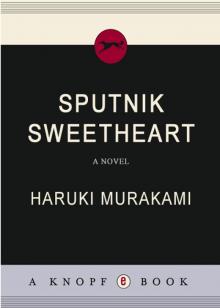 Sputnik Sweetheart
Sputnik Sweetheart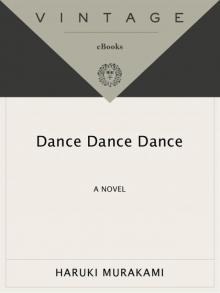 Dance Dance Dance
Dance Dance Dance The Wind (1) and Up Bird Chronicle (2)
The Wind (1) and Up Bird Chronicle (2) Blind Willow, Sleeping Woman
Blind Willow, Sleeping Woman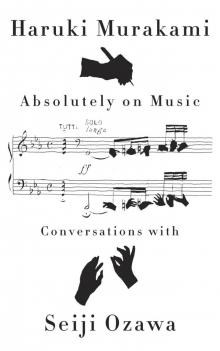 Absolutely on Music: Conversations With Seiji Ozawa
Absolutely on Music: Conversations With Seiji Ozawa Norwegian Wood
Norwegian Wood South of the Border, West of the Sun
South of the Border, West of the Sun Kafka on the Shore
Kafka on the Shore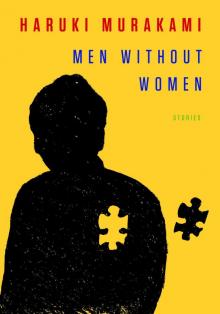 Men Without Women
Men Without Women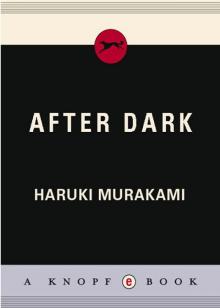 After Dark
After Dark Hard-Boiled Wonderland and the End of the World
Hard-Boiled Wonderland and the End of the World 1q84
1q84 The Wind-Up Bird Chronicle
The Wind-Up Bird Chronicle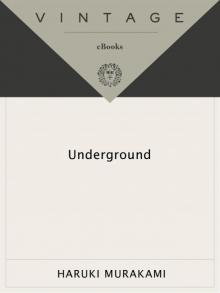 Underground: The Tokyo Gas Attack and the Japanese Psyche
Underground: The Tokyo Gas Attack and the Japanese Psyche Vintage Murakami
Vintage Murakami The Elephant Vanishes: Stories
The Elephant Vanishes: Stories Colorless Tsukuru Tazaki and His Years of Pilgrimage
Colorless Tsukuru Tazaki and His Years of Pilgrimage First Person Singular
First Person Singular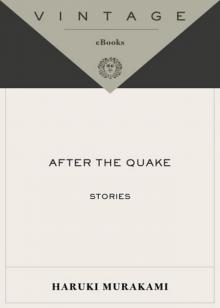 After the Quake
After the Quake A Wild Sheep Chase
A Wild Sheep Chase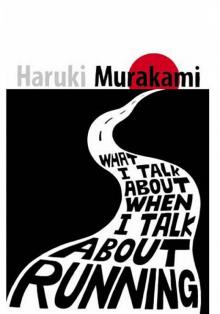 What I Talk About When I Talk About Running
What I Talk About When I Talk About Running Birthday Girl
Birthday Girl The Elephant Vanishes
The Elephant Vanishes Norwegian Wood (Vintage International)
Norwegian Wood (Vintage International) Wind/Pinball
Wind/Pinball Norwegian Wood Vol 1.
Norwegian Wood Vol 1.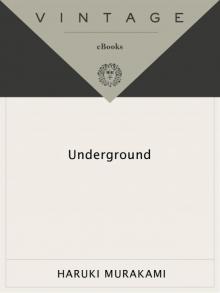 Underground
Underground Colorless Tsukuru Tazaki and His Years of Pilgrimage: A novel
Colorless Tsukuru Tazaki and His Years of Pilgrimage: A novel Killing Commendatore
Killing Commendatore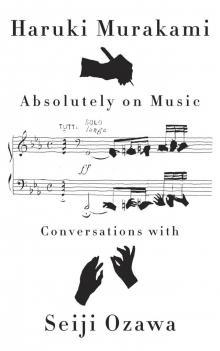 Absolutely on Music
Absolutely on Music